Aged kimchi
Every year in late fall, I make enough kimchi to last through the winter and spring. After aging, the kimchi becomes sour and packs rich flavor, making it perfect for stews or soups! This kimchi jjim is a family favorite!
In Korea, mukeunji (묵은지), which is traditional poggi kimchi that has aged over at least a six-month period, is commonly used for this dish. The flavor of that old kimchi is quite intense. Some Korean restaurants offer mukeunji dishes such as mukenji jjim (pork-braised) and mukeunji godeungeo jorim (mackerel-braised).
Don’t worry! Your kimchi doesn’t need to be 6 months old for you to make this dish. However, it’s best to use well fermented kimchi that has turned sour. The older the better! If you don’t have homemade kimchi, your Korean market may carry commercially made poggi kimchi.
The meat
Fatty pork is the most popular meat choice for kimchi jjigae in Korea. As I always say, kimchi and fatty pork make a perfect pair. It’s no surprise pork ribs are common and delicious in kimchi stew. If using them, cook the ribs until they’re somewhat tender by boiling them for 20-30 minutes, and then cook them with kimchi.
Tips for making good kimchi jjim
- Old, sour kimchi is the best for this dish.
- Use the water used to rinse rice (ssalddeumul, 쌀뜨물) for the braising liquid. It’s commonly used for Korean stews. Use the water from the second or third round of rinsing. The rice water thickens the broth slightly and enhances the flavor of the braised kimchi. Otherwise Anchovy broth, chicken broth, milky bone broth or vegetable broth will also be great for this dish.
- If juice from kimchi is available, it will add lots of flavor to the broth.
- You can cut kimchi into small pieces before cooking, but in Korea it’s commonly made with the quarter cabbage intact as shown in the photo below and cut at the table.
- If the kimchi is overly sour, add a little sugar to the stew to balance out the sour taste. It rounds up the flavor nicely, but it’s not absolutely necessary if you don’t want to use sugar.
More recipes with old kimchi
For more Korean cooking inspirations, follow along on YouTube, Pinterest, Twitter, Facebook, and Instagram.
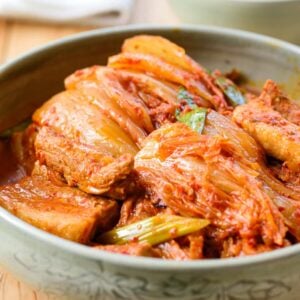
Ingredients
- 6 ounces pork belly or shoulder (or beef chuck or brisket)
- 1 teaspoon grated ginger
- 1 tablespoon minced garlic
- 1.5 pounds kimchi (1 quarter of the whole napa cabbage) You can use more or less kimchi. Simply adjust the water amounts.
- 1/2 cup juice from kimchi
- 1.5 cups water (or anchovy broth) If making rice, use the water used to rinse rice (ssalddeumul, 쌀뜨물) instead of plain water.
- 1 to 2 teaspoons gochugaru (Korean red chili pepper flakes)
- 1 or 2 scallions, roughly chopped
- 1 teaspoon sugar You can omit if you like. (see note)
Instructions
- Cut the pork meat into large chunks (about 1/2-inch thick). In a pot, preferably with a thick bottom, combine the meat with the ginger and garlic.
- Cut the kimchi crosswise into 2 or 3 sections or use the whole quarter cabbage kimchi intact.
- Add to the pot with the meat. Add the kimchi juice, water(or broth), and gochugaru. Bring it to a boil over medium high heat. Reduce the heat to medium low. Simmer, covered, until the kimchi and meat are tender, about 40 minutes. If the liquid is evaporating too quickly, add more water (or broth) or reduce the heat.
- Stir in the scallions and sugar, 5 minutes before turning the heat off. Serve with cooked rice.
Notes
This kimchi jjim recipe was originally posted in March 2013. I’ve updated here with new photos, more information, and minor improvements to the recipe.


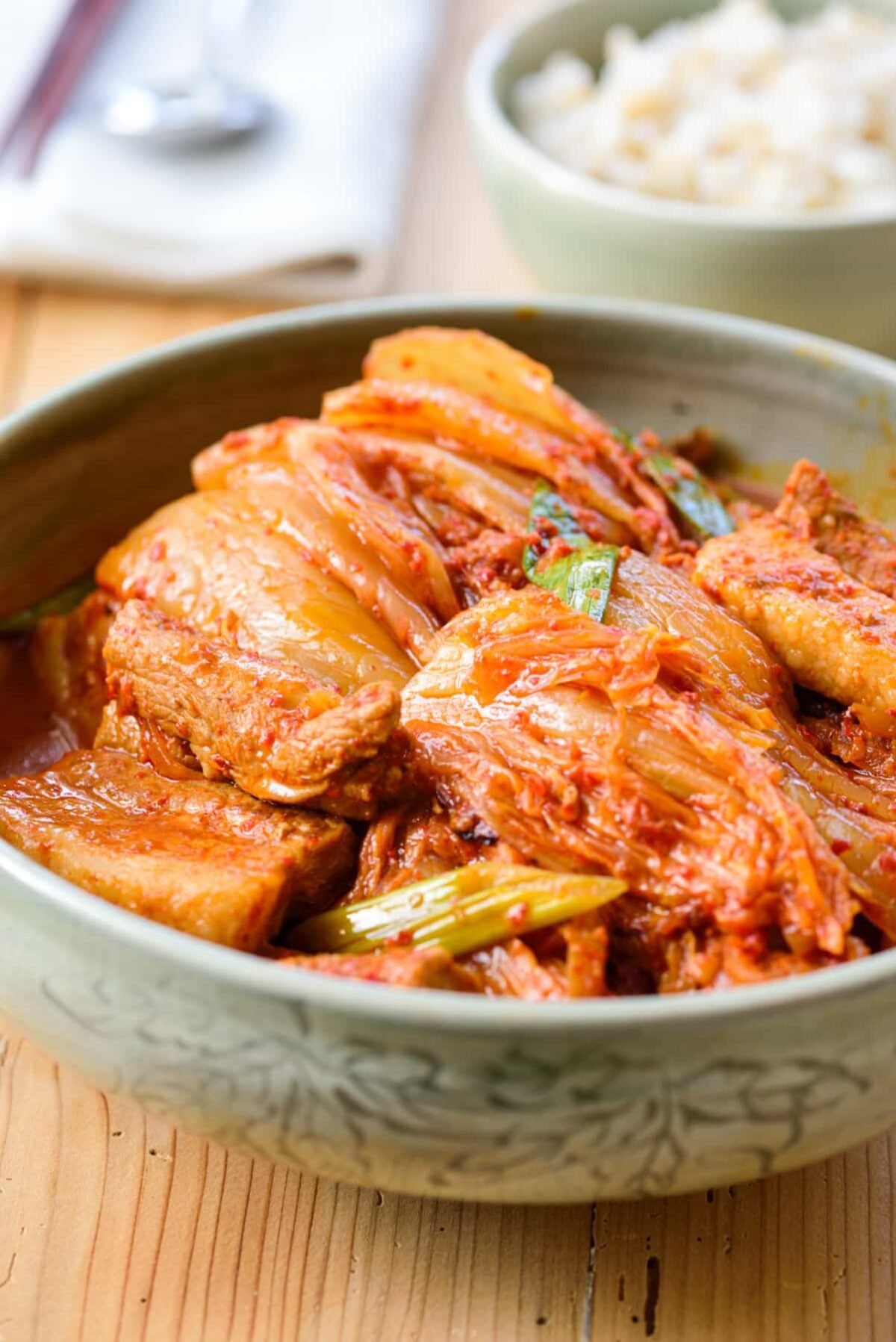
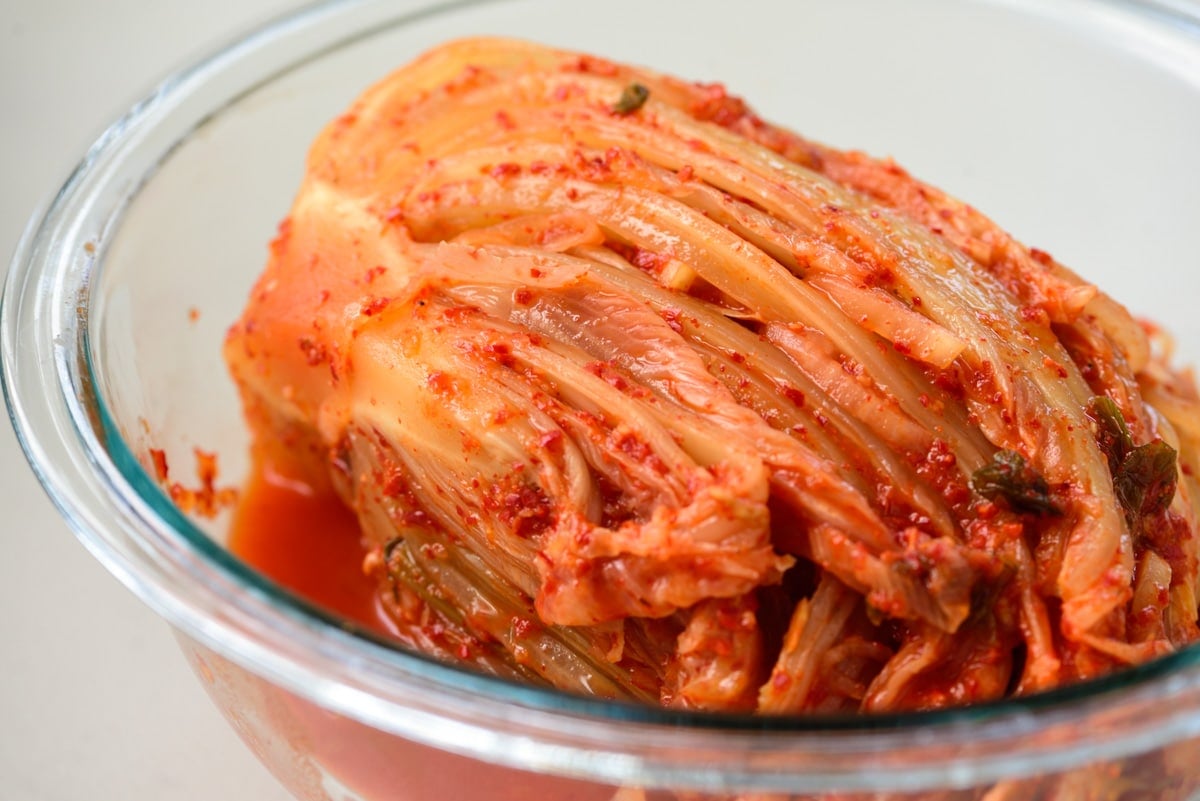
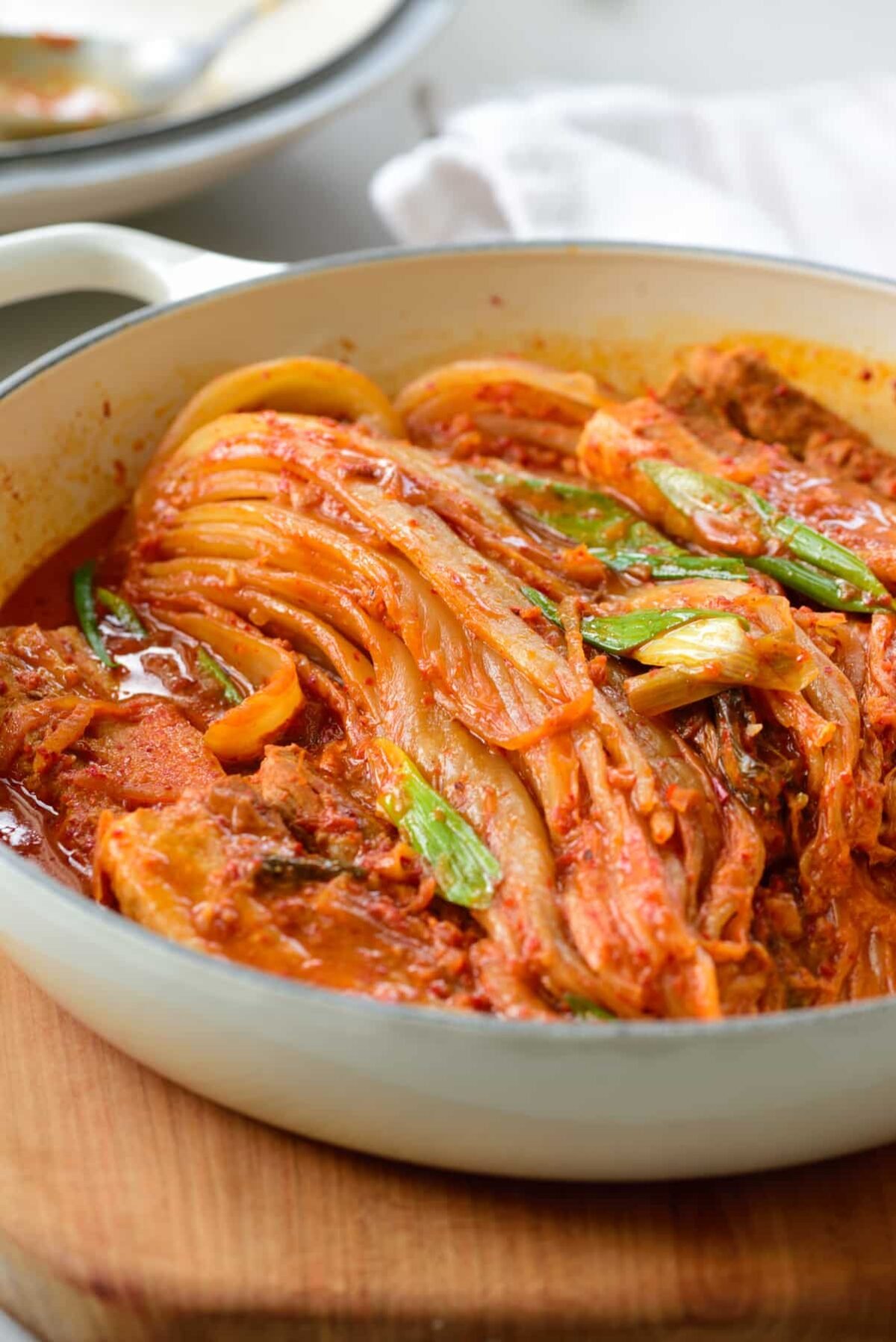
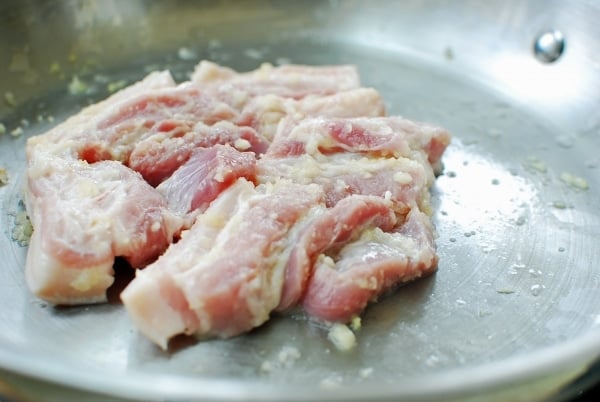
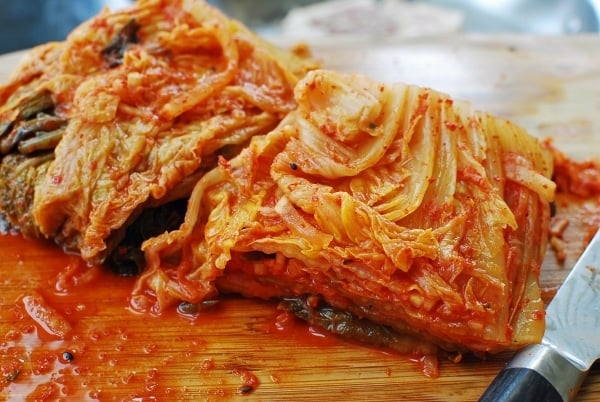
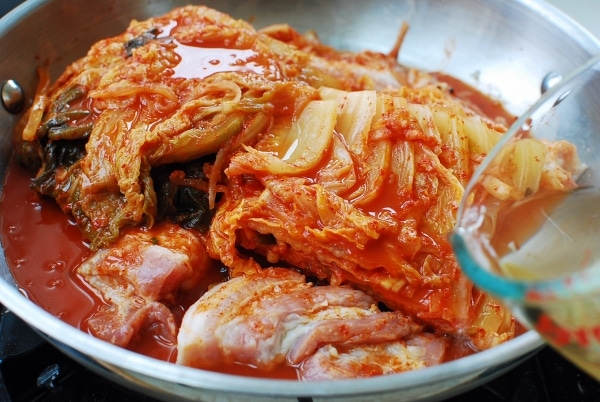
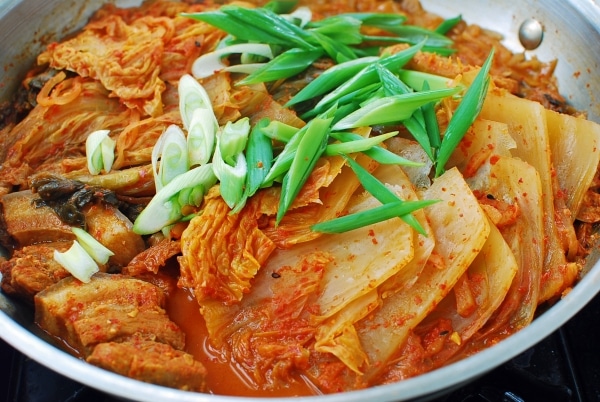
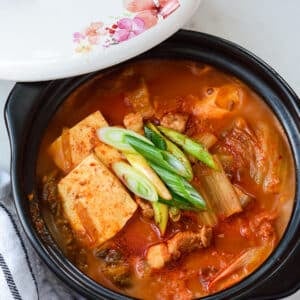
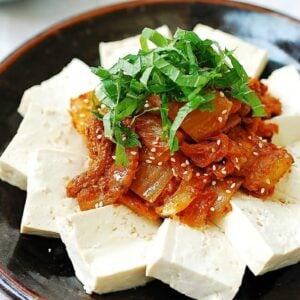
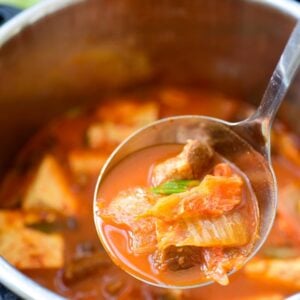
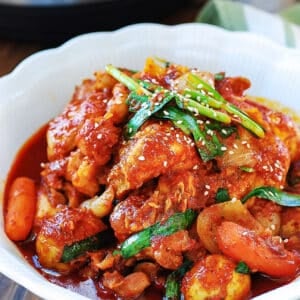













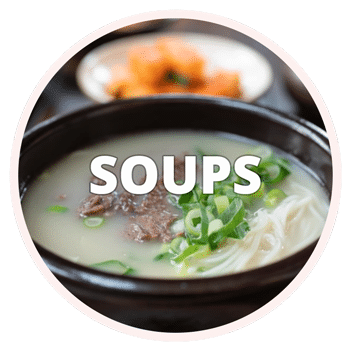



Eun-Ju says
Instead of pork or beef, can I make this with tuna?
Hyosun says
Yes you can, but boil the kimchi first and then add tuna with 10 to 20 min remaining.
Bella says
This recipe is tasty! I’ve been a fan of kimchi for a long time, and this recipe makes a version with a great concentrated flavor. I’m not Korean, but my husband is, and he enjoys eating these recipes as well. I was using a different website but I find the recipes on this site consistently reliable. They meet my experience and expectations with the taste. Thank you for being thorough while not presenting overly complicated or involved recipes!
Sharon says
Hello! Your recipes are always so on point and delicious! Thank you so much always!
I was wondering if you had the instant pot variation for this recipe. I need to make more use of my instant pot and this is one recipe i’ve been trying to find to do!
Thank you!
Hyosun says
Hi Sharon – Thank you for the nice words! I have Instant Pot kimchi jjigae, but this recipe will work well in the Instant Pot. Simply add to the Instant Pot, for the recipe step “Add to the post with the meat…” I think 12 to 15 min pressure cooking and quick release. See the Instant Pot kimchi jjigae recipe for reference. Hope this helps.
Aditi says
Hi,
I am vegetarian but was hoping to make this dish. Is there any particular vegetables that might work for this recipe or can i cook any vegetables I like and combine the kimich with it and cook it?
ErminFei says
You can use diced mushroom and onionwrapped in the kimchi leaves. Or add tofu?
Hyosun says
yes for mushrooms and onion, but there’s probably not enough liquid to boil tofu with it. Why don’t you just use regular kimchi jjigae recipe?
Deborah says
Hi: I am from Canada, have spent long periods of time in Korea. One of the things I miss the most is GODENGO JJORIM! Steamed mackerel in a ttukbegae (or dolsot) with gorgeous thick, rich, gochang and mu (radish). Do you have a recipe to share?
Thank you!!!!! (Lovely website)!
Milton says
i cannot wait to make this. We visit Lotte market in Centreville VA every couple of months and stock up for our korean pantry. We always overbuy our kimchee (they have SO much) .. now i have a perfect recipe. I love your site and the ability to make Korean goodies at home!!
Hyosun says
I go there sometimes too. You can’t have too much kimchi. There are so many dishes you can make with kimchi. This is one of my favorite. Thanks for taking the time to comment here!
Deborah says
Greetings from Canada! Tae dan hi kamsah hamnidah – what a wonderful website. I was actually looking for a recipe for godengo kimchi jjim which I had on Friday night and am still dreaming about! Excellent website. I have marked this in my favourites.
Hyosun says
Where did you have that awesome godengeo kimchi jjim? Welcome to my blog! Hope you find many recipes you like to try. Thanks!
sosopie says
Wow, I didn’t know kimchi could last 6 months! I do remember digging up an urn of kimchi way back in the past in Korea… I think it was kept there during the cold winter months, but I was so young, it’s a vague memory. I think I’m lucky if kimchi keeps two weeks in my fridge. They get overly fermented very quickly. This looks really yummy!
Sandra Mihic says
What a great recipe and i have to agree with Holly about it…it’s something else when those two combine! Your pics are so mouthwatering. Thank you for sharing your recipe!
Holly | Beyond Kimchee says
The overly sour kimchi(moogeunji) braised with pork is to die for good. There is something about pork fat mingling with fermented cabbage. It is just so salivating. Thanks for the wonderful recipe, Hyosun.
Karen says
thanks for the recipe! makes me miss life in Korea so much
Sue | My Korean Kitchen says
Oh my! My mouth is watering! It looks so delicious. You must have a Kimchi fridge at home. I’m making some Kimchi today (not a lot, just a half cabbage worth) but I think I should make heaps of Kimchi from next time to make this Kimchi Jjim!
Hyosun Ro says
I don’t actually have a kimchi fridge. It’s been on my wish list for a long time. But, I have an extra fridge, so that helps. It’s time for me to make another big batch while cabbages and radishes are still good. You know it’s well worth the time and effort. Thanks for stopping by.
C says
I only have chopped kimchi, would you recommend altering the recipe in any way to accommodate the smaller pieces?
Hyosun says
Make kimchi jjigae! https://www.koreanbapsang.com/kimchi-jjigae-kimchi-stew/